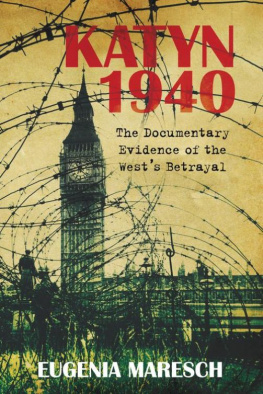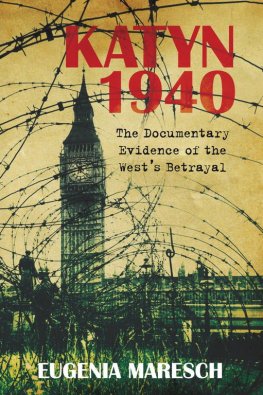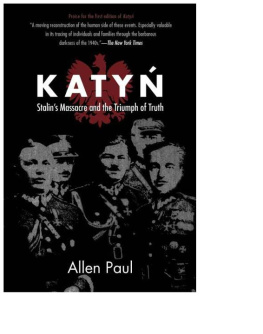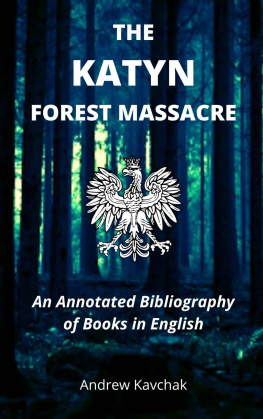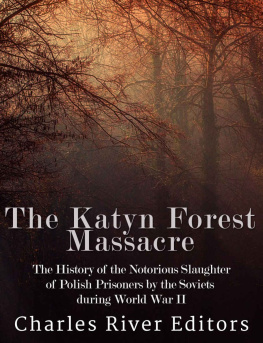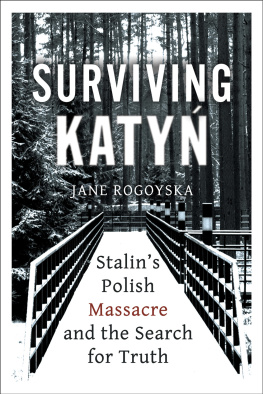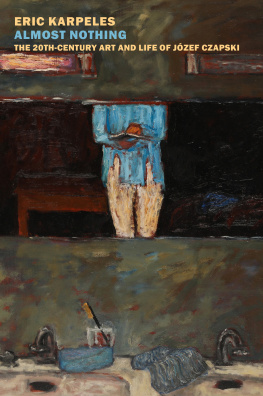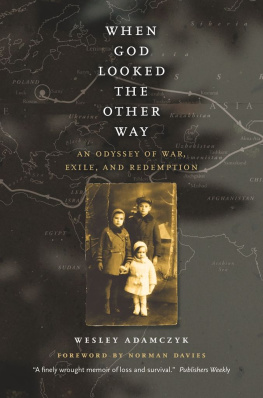If it be the case that a monstrous crime has been committed by a foreign government albeit a friendly one and that we, for however valid reasons, have been obliged to behave as if the deed was not theirs, may it not be that we now stand in danger of bemusing not only others but ourselves? We ought, maybe, to ask ourselves how, consistent with the necessities of our relations with the Soviet Government, the voice of our political conscience is to be kept up to concert pitch. It may be that the answer lies, for the moment, only in something to be done inside our own hearts and minds where we are masters. Here at any rate we can make a compensatory contribution a reaffirmation of our allegiance to truth and justice and compassion.
Owen OMalley
Dedication
To my life-long friend and mentor, prelate Lt Zdzisaw Peszkowski, survivor of Kozielsk camp, who in 1944 became a Scout leader to thousands of Polish refugee children myself included and to Dr Zdzisaw Jagodziski, historian, librarian and first editor of the Katyn bibliography, my courageous friend and colleague; both now departed, without ever seeing the fruits of their inspiration.
Front cover: Big Ben, Wartime London. (Franklin D. Roosevelt Library ARC 195565)
CONTENTS
Lieutenant General Mason MacFarlanes Report Lieutenant Bronisaw Mynarskis Report Captain Jzef Czapskis Report The Foreign Office Comments Lieutenant Colonel Leslie Hulls Report Professor Stanisaw Swianiewicz Declaration
General Anders Speech Ambassador OMalleys Involvement with Katyn Second Secretary Denis Allens Opinion Sir Alexander Cadogans Remarks Diplomatic Dilemmas and Attitudes German Secure Signals Auswartiges Amt SOE Interests in Katyn
Stanisaw Wjciks MI 19 Interrogation Ferdynand Goetels Recollections Ivan Krivozertsevs Deposition Polish Red Cross PCK Involvement Kazimierz Skaryskis Report Dr Marian Wodziskis Report Captain Stanley Gilders Report Wodziskis Report Part Two Skaryskis Report Part Two
German Reaction to the Soviet Report Foreign Correspondents and J. Balfours Report Interrogation of Columbine The Soviet Commission of Experts Ambassador OMalley on the Soviet Report The Foreign Office Response Sir Bernard Spilsburys Forensic Observations Professor Orss Confirmation of his Initial Report
Professor Sumners Analysis Sir William Malkins Judgement Skaryskis Conclusions
Akcja Kostar MP Guy Lloyds Involvement Denis Allens Brief Professor Savorys Engagement The Foreign Office Comments Lord Shawcross Statement Ambassador Bullard Remembers Frank Roberts Comments from Moscow Possible Charges against the AK
The Germandt Affair The Timing of Akcja Kostar The Second Phase of AkcjaKostar Polish Appeal for an International Tribunal General Anders Plea The Foreign Office Reply
USA House of Representatives Select Committee Convolutions of the Foreign Office FORDs Reaction to the Madden Report Geoffrey Shaws Opinion Ambassador Sir Oliver Franks Words of Wisdom The British Governments Last Stand
Professor Hudsons A Polish Challenge Janusz Zawodny and Louis FitzGibbon Miesicznik LiterackiBritish Foreign Policy in the Second World War The Daily Telegraph and The Sunday Times The BBC Documentary
MP Airey Neaves Involvement Lord Barnbys Brave Effort Lord Hankeys Brief Parliamentary Debate on Katyn Sir Alec Douglas Home and EE&SDs Brief The Katyn Memorial Fund
Rohan Burlers Memorandum Critical Appraisal of Butlers Report
Russias Response; The PolishRussian Historical Committee The 1940 Soviet Politburo Document British Policy on Katyn in the 1990s The Unquiet Dead of Katyn Still Walk the Earth
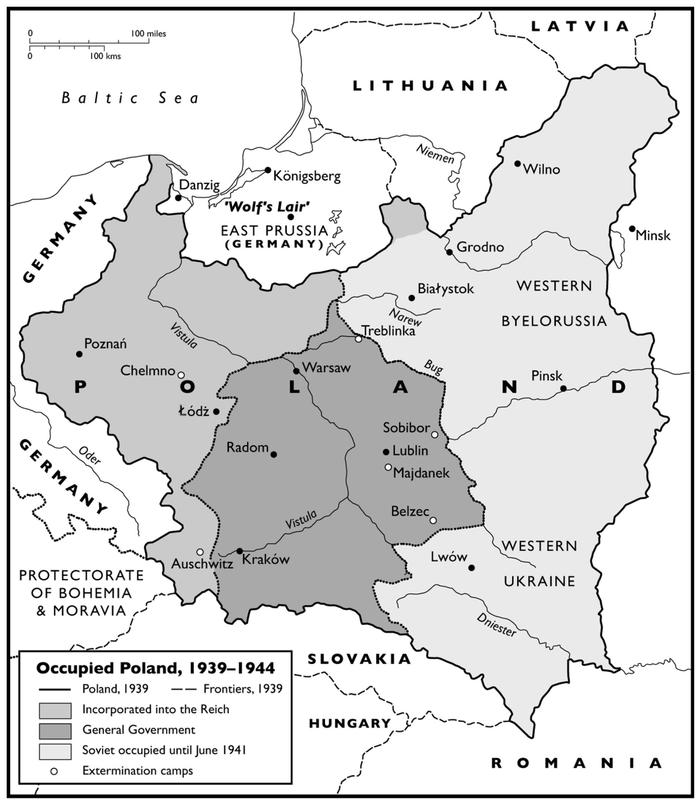
Grateful acknowledgements are made to various archives for permission to reprint previously published material as well as those documents recently declassified, upon which the bulk of this book is based. In particular the National Archives at Kew, the Polish Institute and Sikorski Museum, custodian of surviving records of the Polish government-in-exile based in London. Besides referring to the relevant official histories I have also drawn freely on recent publications by authors from Poland and these are acknowledged in the endnotes.
Debts of gratitude are owed to the personnel of the Polish Institute and Sikorski Museum, and the Polish Underground Movement Study Trust, the National Archives in Poland, the Central Military Archives and the Council for Defence of Memory, Strife and Martyrdom in Warsaw, for their support and encouragement.
Thanks are due to my family, friends and colleagues, amongst them Andrzej Suchcitz, whose counsel I have sought on many occasions, and to David List, especially for his meticulous eye for detail, whose critical reading of the typescript resulted in rational re-examination.
Appreciation is expressed to those who allowed me to use photographs from their family albums. All credits are noted in the captions to those libraries and institutions that provided images.
Seventy years ago, Hitlers quest for domination of Eastern Europe continued with a blistering attack on Poland on 1 September 1939. Seventeen days later, Stalin plunged the knife in Polands back, as agreed by both tyrants on 23 August 1939. The German Foreign Minister Joachim von Ribbentrop and the Soviet Commissar for Foreign Affairs Vyacheslav Molotov signed the German-Soviet Non-Aggression Pact, which contained a Secret Supplementary Protocol dealing with territorial allocations. Initially, boundaries had been along the rivers Narew, Wisa and San, but after the formal German-Soviet Treaty of Friendship and Borders, signed in September, they settled on the Pisa, Narew, Bug and San. The new boundary stretched roughly east of Biaystok, through Brze Litewski (Brest Litovsk) to the west of Lww (Lviv, Lvov), a south-eastern Polish fortress, which for centuries had withstood the invasion of Turkish and Tartar hordes. The Soviet strategy was to create two fronts: the Belorussian heading from Smolensk and the Ukrainian from Kiev, enabling a swift destruction of the Polish regular army divisions and some 24 Frontier Defence Corps (KOP, Korpus Obrony Pogranicza) stationed on the Polish borders. Under the guise of rescuers of the Ukrainian and Belorussian minorities, the Red Army overran the eastern territories of Poland, always known as Kresy, inhabited by 12 million people in just twelve days.
On 18 September 1939 the two aggressors met to discuss further political cooperation; a communiqu was signed, declaring that the sovereignty of Poland had been disestablished. The demarcation line was confirmed and the new territorial sphere of influence endorsed. As early as 19 September 1939, Lavrenty Beria,
approval, which was endorsed by the Politburo of the Communist Central Committee on 4 December to organize four mass deportations of Polish civilians to the wilderness of Siberia and other Soviet Republics. In 19401941, according to migr sources, at least 980,000 were deported; incomplete statistics, gathered to date from GULagsNKVD documents, show only 316,000. These were combatants of the 1920 war with their families, landowners, police and civil servants, enemies of communism and counter-revolutionaries, destined for hard labour and death.
December was also a month of intensive consultations between Germany and Russia on the subject of the massive prisoner problem. Three joint meetings of the security services the UPV and the Gestapo for RSHA, the Reich Central Security Office (Reichsicherheitshauptamt), were held to discuss the possibility of territorial exchange of the PoWs as well as relocation of forced labour to

